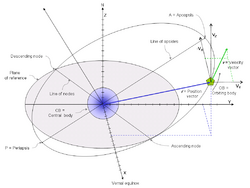| Display title | Orbital state vectors |
| Default sort key | Orbital state vectors |
| Page length (in bytes) | 6,731 |
| Namespace ID | 0 |
| Page ID | 188838 |
| Page content language | en - English |
| Page content model | wikitext |
| Indexing by robots | Allowed |
| Number of redirects to this page | 0 |
| Counted as a content page | Yes |
| Page image |  |
| HandWiki item ID | None |
| Edit | Allow all users (infinite) |
| Move | Allow all users (infinite) |
| Page creator | imported>NBrush |
| Date of page creation | 21:18, 6 February 2024 |
| Latest editor | imported>NBrush |
| Date of latest edit | 21:18, 6 February 2024 |
| Total number of edits | 1 |
| Recent number of edits (within past 90 days) | 0 |
| Recent number of distinct authors | 0 |
Description | Content |
Article description: (description)
This attribute controls the content of the description and og:description elements. | In astrodynamics and celestial dynamics, the orbital state vectors (sometimes state vectors) of an orbit are
Cartesian vectors of position ($ \mathbf {r} $) and velocity ($ \mathbf {v} $) that together with their time (epoch) ($ t $) uniquely determine the trajectory of the orbiting body in space. |

